child restraint MERCEDES-BENZ B-CLASS HATCHBACK 2008 User Guide
[x] Cancel search | Manufacturer: MERCEDES-BENZ, Model Year: 2008, Model line: B-CLASS HATCHBACK, Model: MERCEDES-BENZ B-CLASS HATCHBACK 2008Pages: 305, PDF Size: 5.1 MB
Page 50 of 305
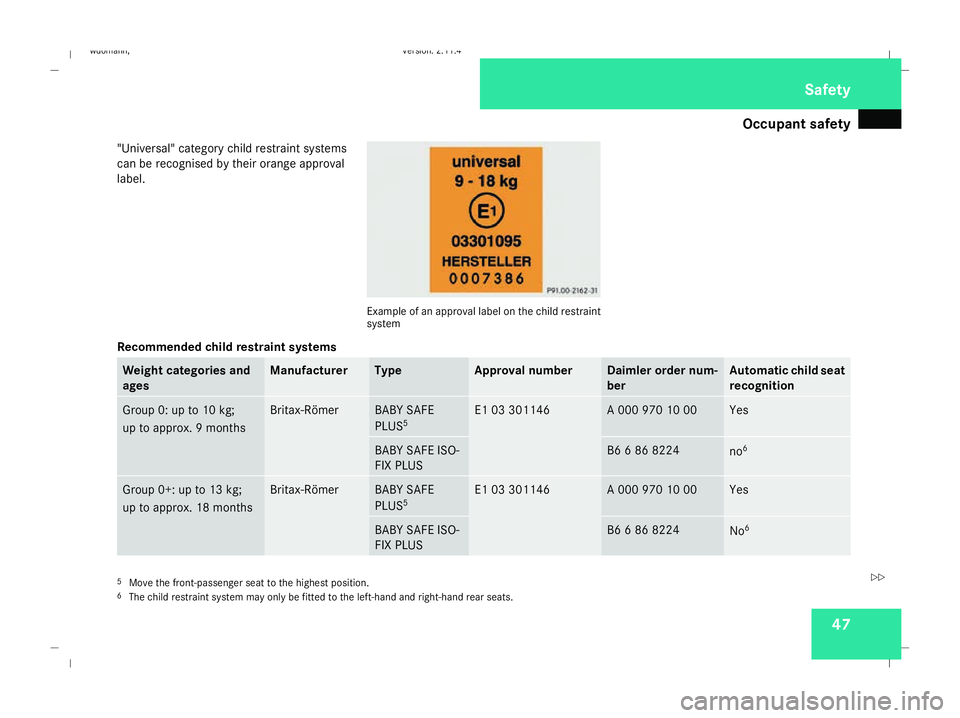
Occupant safety
47
"Universal" category child restraint systems
can be recognised by their orange approval
label. Example of an approval label on the child restraint
system
Recommended child restraint systems Weight categories and
ages Manufacturer Type Approval number Daimler order num-
ber Automatic child seat
recognition
Group 0: up to 10 kg;
up to approx. 9 months Britax-Römer BABY SAFE
PLUS
5 E1 03 301146 A 000 970 10 00 Yes
BABY SAFE ISO-
FIX PLUS B6 6 86 8224
no
6 Group 0+: up to 13 kg;
up to approx. 18 months Britax-Römer BABY SAFE
PLUS
5 E1 03 301146 A 000 970 10 00 Yes
BABY SAFE ISO-
FIX PLUS B6 6 86 8224
No
6 5
Move the front-passenger seat to the highest position.
6 The child restraint system may only be fitted to the left-hand and right-hand rear seats. Safety
245_AKB; 2; 7, en-GB
wdomann,
Version: 2.11.4
2008-10-17T11:22:31+02:00 - Seite 47 ZDateiname: 6515_1640_02_buchblock.pdf; preflight
Page 51 of 305
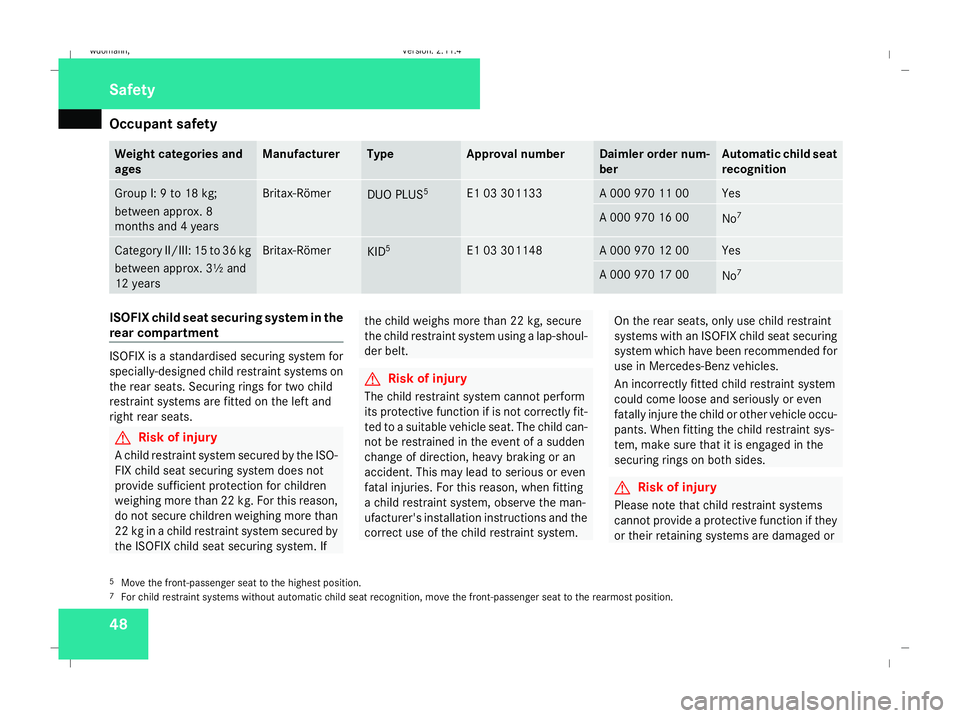
Occupant safety
48 Weight categories and
ages Manufacturer Type Approval number Daimler order num-
ber Automatic child seat
recognition
Group I: 9 to 18 kg;
between approx. 8
months and 4 years Britax-Römer
DUO PLUS
5 E1 03 301133 A 000 970 11 00 Yes
A 000 970 16 00
No
7 Category II/III: 15 to 36 kg
between approx. 3½ and
12 years Britax-Römer
KID
5 E1 03 301148 A 000 970 12 00 Yes
A 000 970 17 00
No
7 ISOFIX child seat securing system in the
rear compartment
ISOFIX is a standardised securing system for
specially-designed child restraint systems on
the rear seats. Securing rings for two child
restraint systems are fitted on the left and
right rear seats. G
Risk of injury
A child restraint system secured by the ISO-
FIX child seat securing system does not
provide sufficient protection for children
weighing more than 22 kg. For this reason,
do not secure children weighing more than
22 kg in a child restraint system secured by
the ISOFIX child seat securing system. If the child weighs more than 22 kg, secure
the child restraint system using a lap-shoul-
der belt. G
Risk of injury
The child restraint system cannot perform
its protective function if is not correctly fit-
ted to a suitable vehicle seat. The child can-
not be restrained in the event of a sudden
change of direction, heavy braking or an
accident. This may lead to serious or even
fatal injuries. For this reason, when fitting
a child restraint system, observe the man-
ufacturer's installation instructions and the
correct use of the child restraint system. On the rear seats, only use child restraint
systems with an ISOFIX child seat securing
system which have been recommended for
use in Mercedes-Benz vehicles.
An incorrectly fitted child restraint system
could come loose and seriously or even
fatally injure the child or other vehicle occu-
pants. When fitting the child restraint sys-
tem, make sure that it is engaged in the
securing rings on both sides.
G
Risk of injury
Please note that child restraint systems
cannot provide a protective function if they
or their retaining systems are damaged or
5 Move the front-passenger seat to the highest position.
7 For child restraint systems without automatic child seat recognition, move the front-passenger seat to the rearmost position. Safety
245_AKB; 2; 7, en-GB
wdomann
,V ersion: 2.11.4
2008-10-17T11:22:31+02:00 - Seite 48 Dateiname: 6515_1640_02_buchblock.pdf; preflight
Page 52 of 305
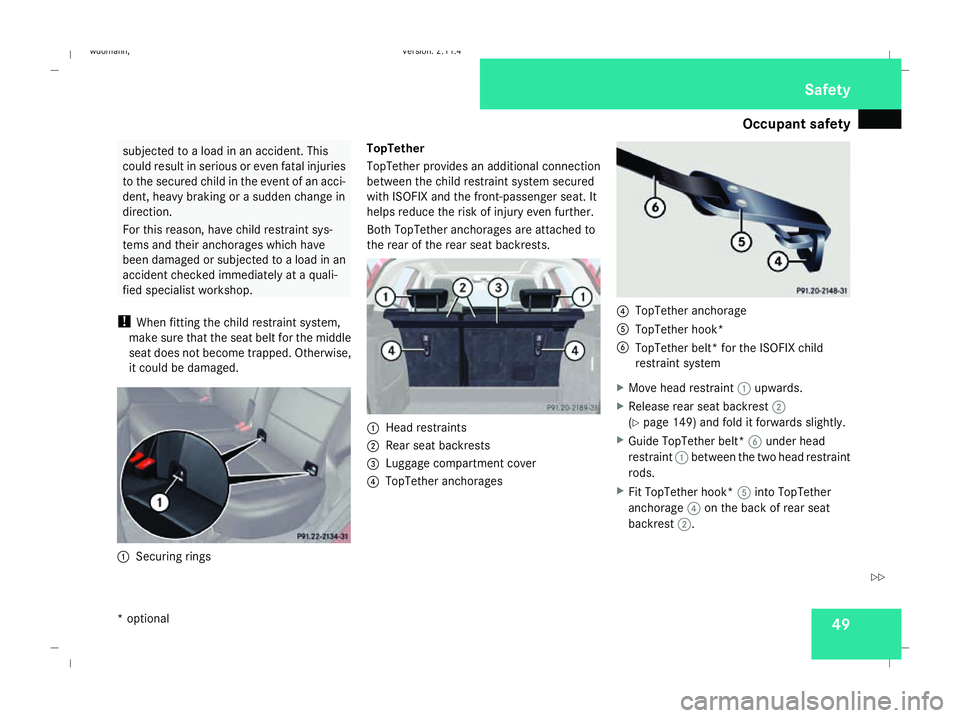
Occupant safety
49subjected to a load in an accident. This
could result in serious or even fatal injuries
to the secured child in the event of an acci-
dent, heavy braking or a sudden change in
direction.
For this reason, have child restraint sys-
tems and their anchorages which have
been damaged or subjected to a load in an
accident checked immediately at a quali-
fied specialist workshop.
! When fitting the child restraint system,
make sure that the seat belt for the middle
seat does not become trapped. Otherwise,
it could be damaged. 1
Securing rings TopTether
TopTether provides an additional connection
between the child restraint system secured
with ISOFIX and the front-passenger seat. It
helps reduce the risk of injury even further.
Both TopTether anchorages are attached to
the rear of the rear seat backrests.
1
Head restraints
2 Rear seat backrests
3 Luggage compartment cover
4 TopTether anchorages 4
TopTether anchorage
5 TopTether hook*
6 TopTether belt* for the ISOFIX child
restraint system
X Move head restraint 1upwards.
X Release rear seat backrest 2
(Y page 149) and fold it forwards slightly.
X Guide TopTether belt* 6under head
restraint 1between the two head restraint
rods.
X Fit TopTether hook* 5into TopTether
anchorage 4on the back of rear seat
backrest 2. Safety
* optional
245_AKB; 2; 7, en-GB
wdomann,
Version: 2.11.4 2008-10-17T11:22:31+02:00 - Seite 49 ZDateiname: 6515_1640_02_buchblock.pdf; preflight
Page 53 of 305
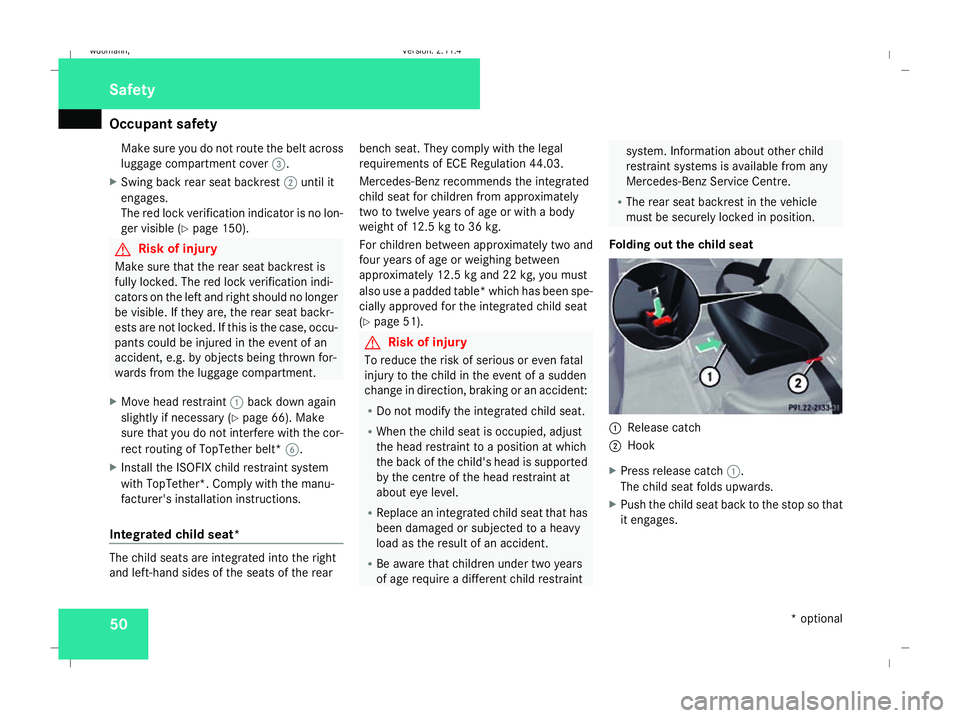
Occupant safety
50Make sure you do not route the belt across
luggage compartment cover
3.
X Swing back rear seat backrest 2until it
engages.
The red lock verification indicator is no lon-
ger visible (Y page 150). G
Risk of injury
Make sure that the rear seat backrest is
fully locked. The red lock verification indi-
cators on the left and right should no longer
be visible. If they are, the rear seat backr-
ests are not locked. If this is the case, occu-
pants could be injured in the event of an
accident, e.g. by objects being thrown for-
wards from the luggage compartment.
X Move head restraint 1back down again
slightly if necessary (Y page 66). Make
sure that you do not interfere with the cor-
rect routing of TopTether belt* 6.
X Install the ISOFIX child restraint system
with TopTether*. Comply with the manu-
facturer's installation instructions.
Integrated child seat* The child seats are integrated into the right
and left-hand sides of the seats of the rear bench seat. They comply with the legal
requirements of ECE Regulation 44.03.
Mercedes-Benz recommends the integrated
child seat for children from approximately
two to twelve years of age or with a body
weight of 12.5 kg to 36 kg.
For children between approximately two and
four years of age or weighing between
approximately 12.5 kg and 22 kg, you must
also use a padded table* which has been spe-
cially approved for the integrated child seat
(Y page 51). G
Risk of injury
To reduce the risk of serious or even fatal
injury to the child in the event of a sudden
change in direction, braking or an accident:
R Do not modify the integrated child seat.
R When the child seat is occupied, adjust
the head restraint to a position at which
the back of the child's head is supported
by the centre of the head restraint at
about eye level.
R Replace an integrated child seat that has
been damaged or subjected to a heavy
load as the result of an accident.
R Be aware that children under two years
of age require a different child restraint system. Information about other child
restraint systems is available from any
Mercedes-Benz Service Centre.
R The rear seat backrest in the vehicle
must be securely locked in position.
Folding out the child seat 1
Release catch
2 Hook
X Press release catch 1.
The child seat folds upwards.
X Push the child seat back to the stop so that
it engages. Safety
* optional
245_AKB; 2; 7, en-GB
wdomann
,V ersion: 2.11.4
2008-10-17T11:22:31+02:00 - Seite 50 Dateiname: 6515_1640_02_buchblock.pdf; preflight
Page 54 of 305
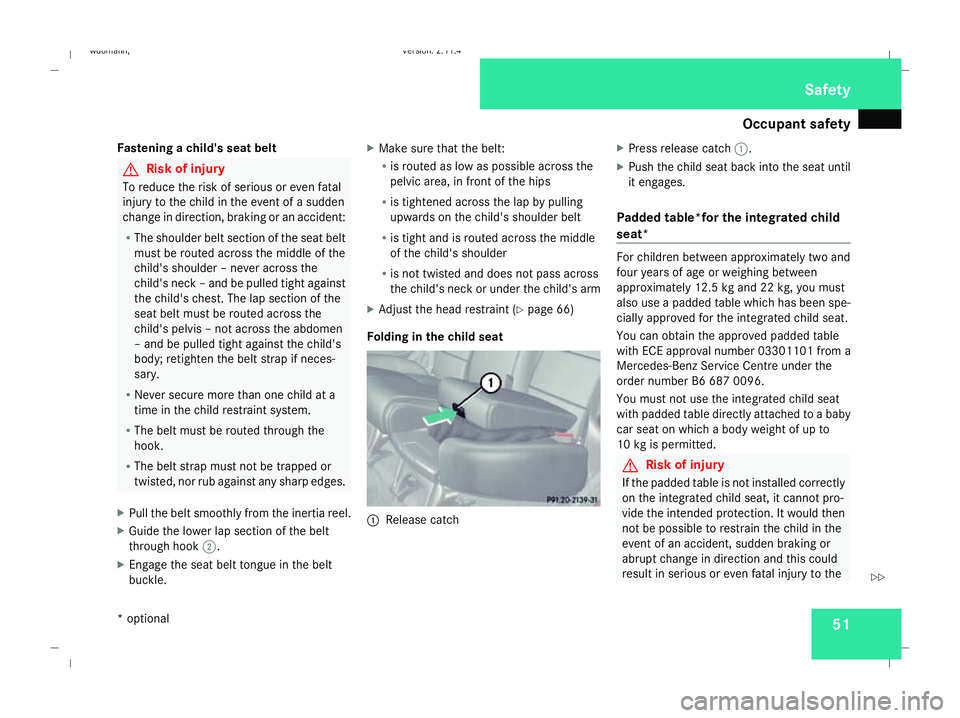
Occupant safety
51
Fastening a child's seat belt G
Risk of injury
To reduce the risk of serious or even fatal
injury to the child in the event of a sudden
change in direction, braking or an accident:
R The shoulder belt section of the seat belt
must be routed across the middle of the
child's shoulder – never across the
child's neck – and be pulled tight against
the child's chest. The lap section of the
seat belt must be routed across the
child's pelvis – not across the abdomen
– and be pulled tight against the child's
body; retighten the belt strap if neces-
sary.
R Never secure more than one child at a
time in the child restraint system.
R The belt must be routed through the
hook.
R The belt strap must not be trapped or
twisted, nor rub against any sharp edges.
X Pull the belt smoothly from the inertia reel.
X Guide the lower lap section of the belt
through hook 2.
X Engage the seat belt tongue in the belt
buckle. X
Make sure that the belt:
R
is routed as low as possible across the
pelvic area, in front of the hips
R is tightened across the lap by pulling
upwards on the child's shoulder belt
R is tight and is routed across the middle
of the child's shoulder
R is not twisted and does not pass across
the child's neck or under the child's arm
X Adjust the head restraint (Y page 66)
Folding in the child seat 1
Release catch X
Press release catch 1.
X Push the child seat back into the seat until
it engages.
Padded table*for the integrated child
seat* For children between approximately two and
four years of age or weighing between
approximately 12.5 kg and 22 kg, you must
also use a padded table which has been spe-
cially approved for the integrated child seat.
You can obtain the approved padded table
with ECE approval number 03301101 from a
Mercedes-Benz Service Centre under the
order number B6 687 0096.
You must not use the integrated child seat
with padded table directly attached to a baby
car seat on which a body weight of up to
10 kg is permitted.
G
Risk of injury
If the padded table is not installed correctly
on the integrated child seat, it cannot pro-
vide the intended protection. It would then
not be possible to restrain the child in the
event of an accident, sudden braking or
abrupt change in direction and this could
result in serious or even fatal injury to the Safety
* optional
245_AKB; 2; 7, en-GB
wdomann,
Version: 2.11.4 2008-10-17T11:22:31+02:00 - Seite 51 ZDateiname: 6515_1640_02_buchblock.pdf; preflight
Page 55 of 305
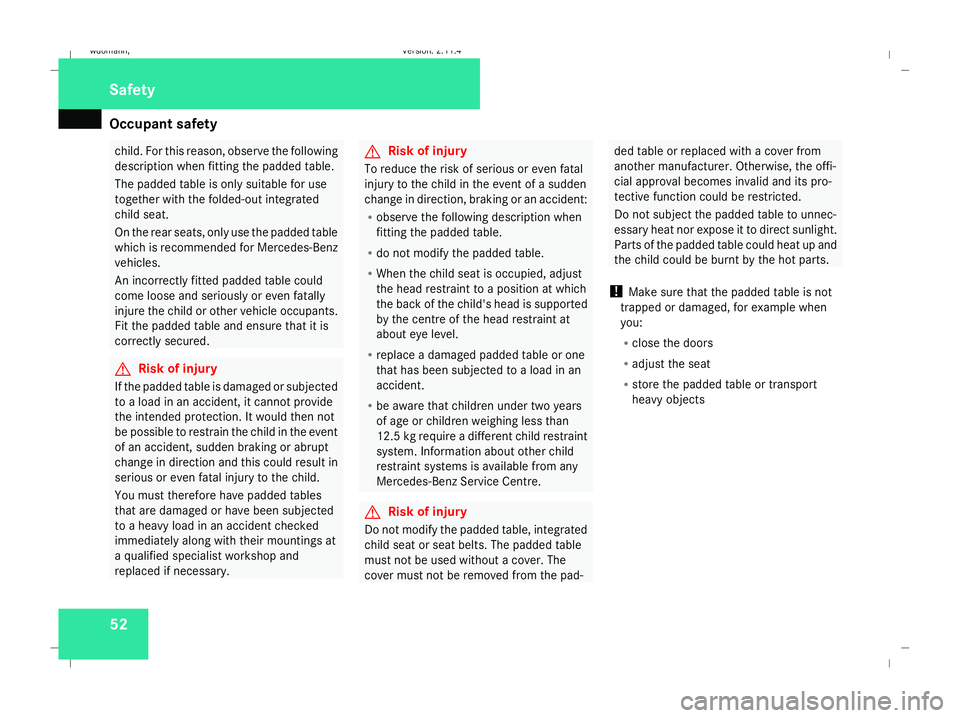
Occupant safety
52 child. For this reason, observe the following
description when fitting the padded table.
The padded table is only suitable for use
together with the folded-out integrated
child seat.
On the rear seats, only use the padded table
which is recommended for Mercedes-Benz
vehicles.
An incorrectly fitted padded table could
come loose and seriously or even fatally
injure the child or other vehicle occupants.
Fit the padded table and ensure that it is
correctly secured. G
Risk of injury
If the padded table is damaged or subjected
to a load in an accident, it cannot provide
the intended protection. It would then not
be possible to restrain the child in the event
of an accident, sudden braking or abrupt
change in direction and this could result in
serious or even fatal injury to the child.
You must therefore have padded tables
that are damaged or have been subjected
to a heavy load in an accident checked
immediately along with their mountings at
a qualified specialist workshop and
replaced if necessary. G
Risk of injury
To reduce the risk of serious or even fatal
injury to the child in the event of a sudden
change in direction, braking or an accident:
R observe the following description when
fitting the padded table.
R do not modify the padded table.
R When the child seat is occupied, adjust
the head restraint to a position at which
the back of the child's head is supported
by the centre of the head restraint at
about eye level.
R replace a damaged padded table or one
that has been subjected to a load in an
accident.
R be aware that children under two years
of age or children weighing less than
12.5 kg require a different child restraint
system. Information about other child
restraint systems is available from any
Mercedes-Benz Service Centre. G
Risk of injury
Do not modify the padded table, integrated
child seat or seat belts. The padded table
must not be used without a cover. The
cover must not be removed from the pad- ded table or replaced with a cover from
another manufacturer. Otherwise, the offi-
cial approval becomes invalid and its pro-
tective function could be restricted.
Do not subject the padded table to unnec-
essary heat nor expose it to direct sunlight.
Parts of the padded table could heat up and
the child could be burnt by the hot parts.
! Make sure that the padded table is not
trapped or damaged, for example when
you:
R close the doors
R adjust the seat
R store the padded table or transport
heavy objects Safety
245_AKB; 2; 7, en-GB
wdomann
,V ersion: 2.11.4
2008-10-17T11:22:31+02:00 - Seite 52 Dateiname: 6515_1640_02_buchblock.pdf; preflight
Page 56 of 305
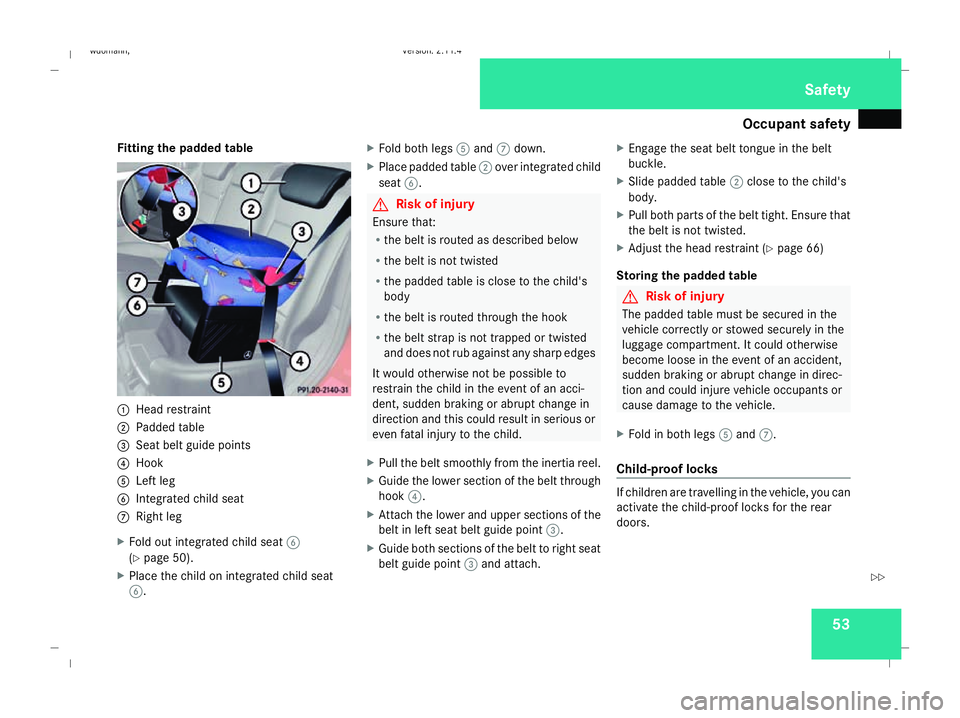
Occupant safety
53
Fitting the padded table
1
Head restraint
2 Padded table
3 Seat belt guide points
4 Hook
5 Left leg
6 Integrated child seat
7 Right leg
X Fold out integrated child seat 6
(Y page 50).
X Place the child on integrated child seat
6. X
Fold both legs 5and 7down.
X Place padded table 2over integrated child
seat 6. G
Risk of injury
Ensure that:
R the belt is routed as described below
R the belt is not twisted
R the padded table is close to the child's
body
R the belt is routed through the hook
R the belt strap is not trapped or twisted
and does not rub against any sharp edges
It would otherwise not be possible to
restrain the child in the event of an acci-
dent, sudden braking or abrupt change in
direction and this could result in serious or
even fatal injury to the child.
X Pull the belt smoothly from the inertia reel.
X Guide the lower section of the belt through
hook 4.
X Attach the lower and upper sections of the
belt in left seat belt guide point 3.
X Guide both sections of the belt to right seat
belt guide point 3and attach. X
Engage the seat belt tongue in the belt
buckle.
X Slide padded table 2close to the child's
body.
X Pull both parts of the belt tight. Ensure that
the belt is not twisted.
X Adjust the head restraint (Y page 66)
Storing the padded table G
Risk of injury
The padded table must be secured in the
vehicle correctly or stowed securely in the
luggage compartment. It could otherwise
become loose in the event of an accident,
sudden braking or abrupt change in direc-
tion and could injure vehicle occupants or
cause damage to the vehicle.
X Fold in both legs 5and 7.
Child-proof locks If children are travelling in the vehicle, you can
activate the child-proof locks for the rear
doors. Safety
245_AKB; 2; 7, en-GB
wdomann
,V ersion: 2.11.4
2008-10-17T11:22:31+02:00 - Seite 53 ZDateiname: 6515_1640_02_buchblock.pdf; preflight
Page 66 of 305
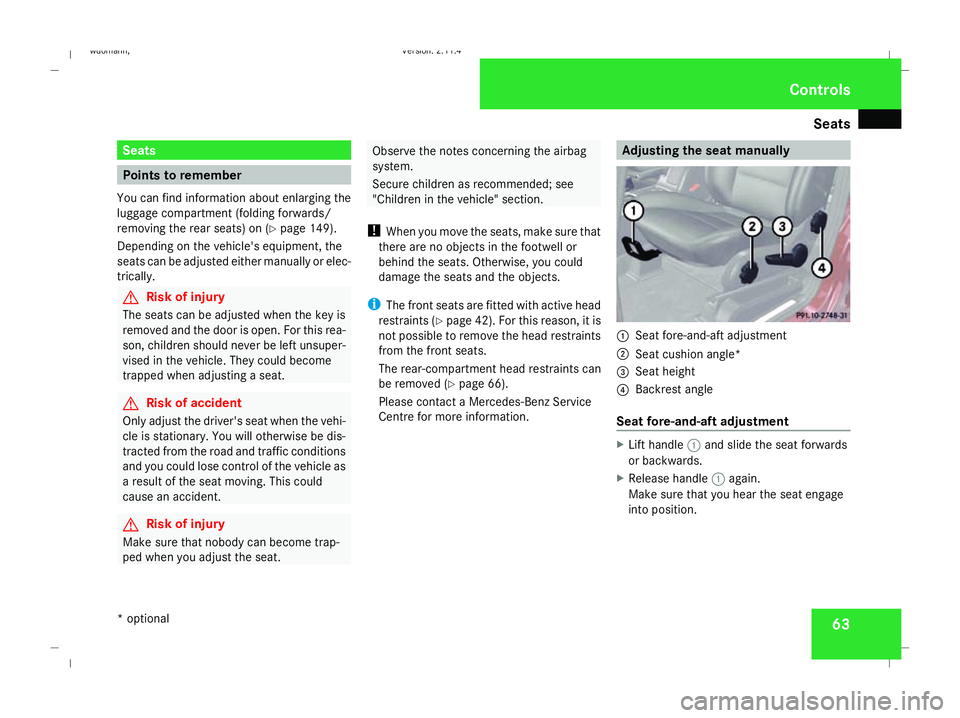
Seats
63Seats
Points to remember
You can find information about enlarging the
luggage compartment (folding forwards/
removing the rear seats) on (Y page 149).
Depending on the vehicle's equipment, the
seats can be adjusted either manually or elec-
trically. G
Risk of injury
The seats can be adjusted when the key is
removed and the door is open. For this rea-
son, children should never be left unsuper-
vised in the vehicle. They could become
trapped when adjusting a seat. G
Risk of accident
Only adjust the driver's seat when the vehi-
cle is stationary. You will otherwise be dis-
tracted from the road and traffic conditions
and you could lose control of the vehicle as
a result of the seat moving. This could
cause an accident. G
Risk of injury
Make sure that nobody can become trap-
ped when you adjust the seat. Observe the notes concerning the airbag
system.
Secure children as recommended; see
"Children in the vehicle" section.
! When you move the seats, make sure that
there are no objects in the footwell or
behind the seats. Otherwise, you could
damage the seats and the objects.
i The front seats are fitted with active head
restraints (Y page 42). For this reason, it is
not possible to remove the head restraints
from the front seats.
The rear-compartment head restraints can
be removed (Y page 66).
Please contact a Mercedes-Benz Service
Centre for more information. Adjusting the seat manually
1
Seat fore-and-aft adjustment
2 Seat cushion angle*
3 Seat height
4 Backrest angle
Seat fore-and-aft adjustment X
Lift handle 1and slide the seat forwards
or backwards.
X Release handle 1again.
Make sure that you hear the seat engage
into position. Controls
* optional
245_AKB; 2; 7, en-GB
wdomann,
Version: 2.11.4 2008-10-17T11:22:31+02:00 - Seite 63 ZDateiname: 6515_1640_02_buchblock.pdf; preflight
Page 75 of 305
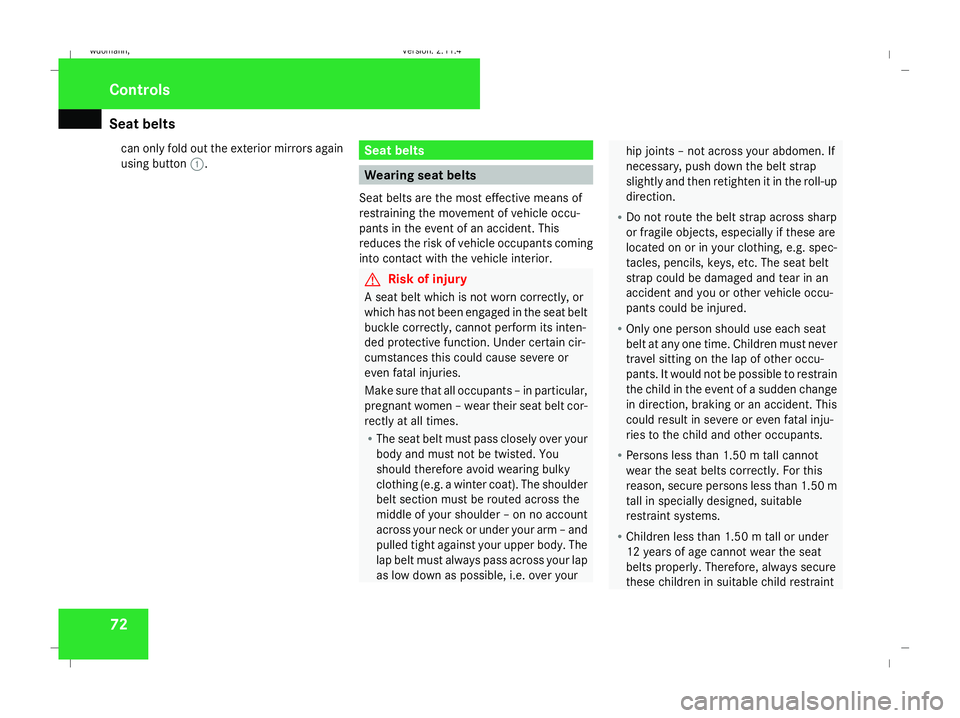
Seat belts
72can only fold out the exterior mirrors again
using button
1. Seat belts
Wearing seat belts
Seat belts are the most effective means of
restraining the movement of vehicle occu-
pants in the event of an accident. This
reduces the risk of vehicle occupants coming
into contact with the vehicle interior. G
Risk of injury
A seat belt which is not worn correctly, or
which has not been engaged in the seat belt
buckle correctly, cannot perform its inten-
ded protective function. Under certain cir-
cumstances this could cause severe or
even fatal injuries.
Make sure that all occupants – in particular,
pregnant women – wear their seat belt cor-
rectly at all times.
R The seat belt must pass closely over your
body and must not be twisted. You
should therefore avoid wearing bulky
clothing (e.g. a winter coat). The shoulder
belt section must be routed across the
middle of your shoulder – on no account
across your neck or under your arm – and
pulled tight against your upper body. The
lap belt must always pass across your lap
as low down as possible, i.e. over your hip joints – not across your abdomen. If
necessary, push down the belt strap
slightly and then retighten it in the roll-up
direction.
R Do not route the belt strap across sharp
or fragile objects, especially if these are
located on or in your clothing, e.g. spec-
tacles, pencils, keys, etc. The seat belt
strap could be damaged and tear in an
accident and you or other vehicle occu-
pants could be injured.
R Only one person should use each seat
belt at any one time. Children must never
travel sitting on the lap of other occu-
pants. It would not be possible to restrain
the child in the event of a sudden change
in direction, braking or an accident. This
could result in severe or even fatal inju-
ries to the child and other occupants.
R Persons less than 1.50 m tall cannot
wear the seat belts correctly. For this
reason, secure persons less than 1.50 m
tall in specially designed, suitable
restraint systems.
R Children less than 1.50 m tall or under
12 years of age cannot wear the seat
belts properly. Therefore, always secure
these children in suitable child restraint Controls
245_AKB; 2; 7, en-GB
wdomann,
Version: 2.11.4 2008-10-17T11:22:31+02:00 - Seite 72Dateiname: 6515_1640_02_buchblock.pdf; preflight
Page 76 of 305
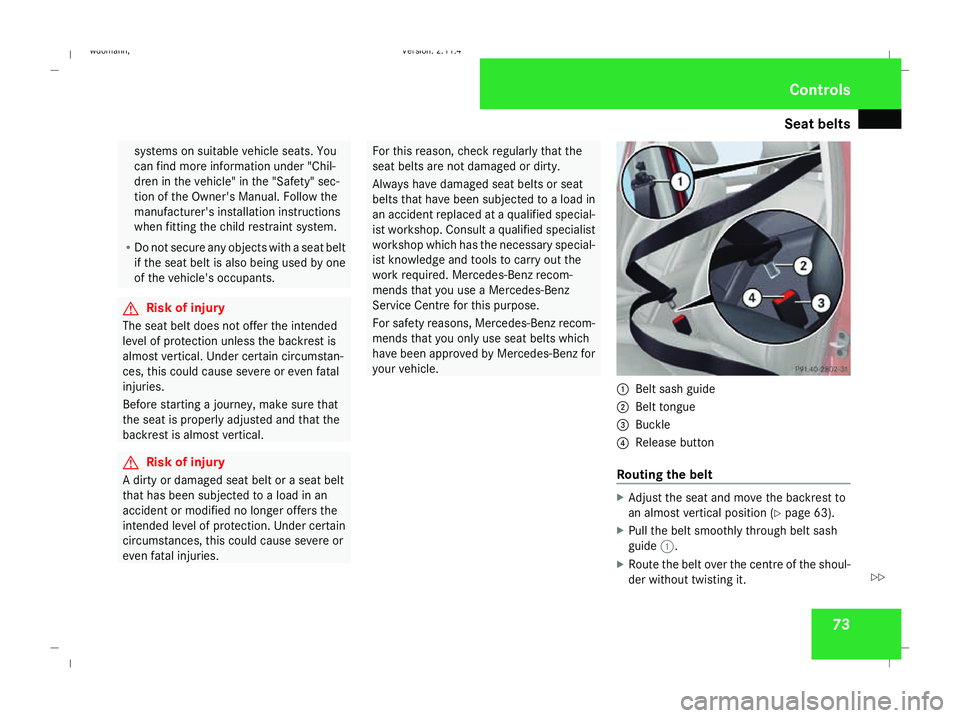
Seat belts
73systems on suitable vehicle seats. You
can find more information under "Chil-
dren in the vehicle" in the "Safety" sec-
tion of the Owner's Manual. Follow the
manufacturer's installation instructions
when fitting the child restraint system.
R Do not secure any objects with a seat belt
if the seat belt is also being used by one
of the vehicle's occupants. G
Risk of injury
The seat belt does not offer the intended
level of protection unless the backrest is
almost vertical. Under certain circumstan-
ces, this could cause severe or even fatal
injuries.
Before starting a journey, make sure that
the seat is properly adjusted and that the
backrest is almost vertical. G
Risk of injury
A dirty or damaged seat belt or a seat belt
that has been subjected to a load in an
accident or modified no longer offers the
intended level of protection. Under certain
circumstances, this could cause severe or
even fatal injuries. For this reason, check regularly that the
seat belts are not damaged or dirty.
Always have damaged seat belts or seat
belts that have been subjected to a load in
an accident replaced at a qualified special-
ist workshop. Consult a qualified specialist
workshop which has the necessary special-
ist knowledge and tools to carry out the
work required. Mercedes-Benz recom-
mends that you use a Mercedes-Benz
Service Centre for this purpose.
For safety reasons, Mercedes-Benz recom-
mends that you only use seat belts which
have been approved by Mercedes-Benz for
your vehicle. 1
Belt sash guide
2 Belt tongue
3 Buckle
4 Release button
Routing the belt X
Adjust the seat and move the backrest to
an almost vertical position (Y page 63).
X Pull the belt smoothly through belt sash
guide 1.
X Route the belt over the centre of the shoul-
der without twisting it. Controls
245_AKB; 2; 7, en-GB
wdomann,
Version: 2.11.4 2008-10-17T11:22:31+02:00 - Seite 73 ZDateiname: 6515_1640_02_buchblock.pdf; preflight